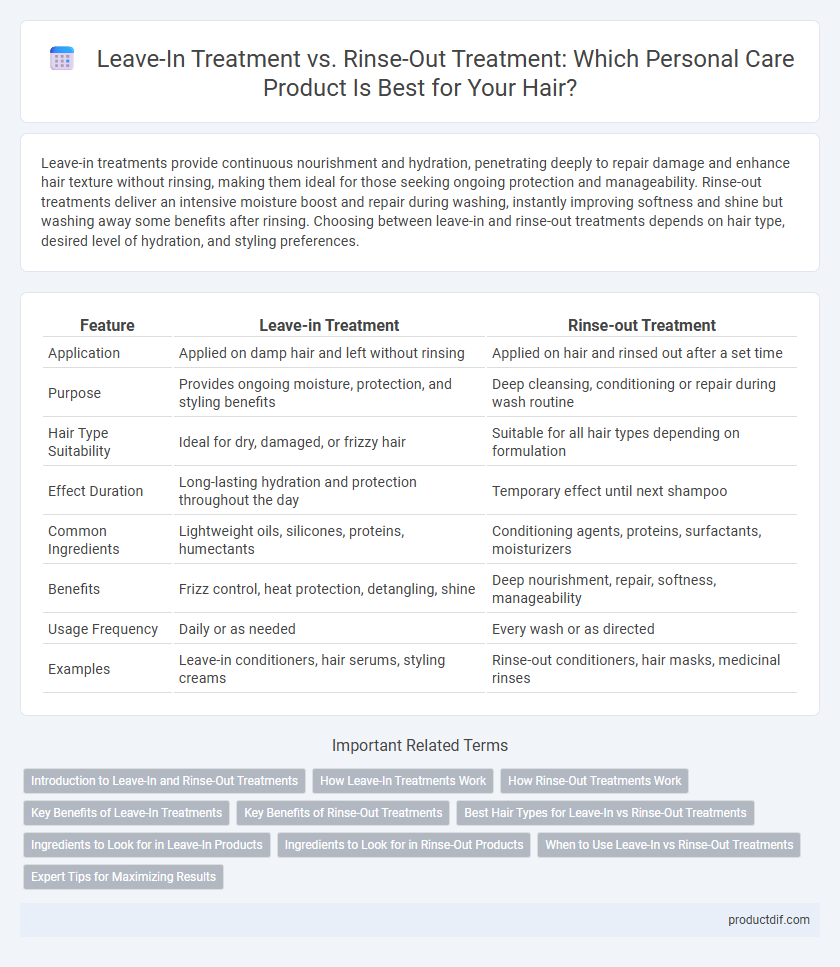Leave-in treatments provide continuous nourishment and hydration, penetrating deeply to repair damage and enhance hair texture without rinsing, making them ideal for those seeking ongoing protection and manageability. Rinse-out treatments deliver an intensive moisture boost and repair during washing, instantly improving softness and shine but washing away some benefits after rinsing. Choosing between leave-in and rinse-out treatments depends on hair type, desired level of hydration, and styling preferences.
Table of Comparison
| Feature | Leave-in Treatment | Rinse-out Treatment |
|---|---|---|
| Application | Applied on damp hair and left without rinsing | Applied on hair and rinsed out after a set time |
| Purpose | Provides ongoing moisture, protection, and styling benefits | Deep cleansing, conditioning or repair during wash routine |
| Hair Type Suitability | Ideal for dry, damaged, or frizzy hair | Suitable for all hair types depending on formulation |
| Effect Duration | Long-lasting hydration and protection throughout the day | Temporary effect until next shampoo |
| Common Ingredients | Lightweight oils, silicones, proteins, humectants | Conditioning agents, proteins, surfactants, moisturizers |
| Benefits | Frizz control, heat protection, detangling, shine | Deep nourishment, repair, softness, manageability |
| Usage Frequency | Daily or as needed | Every wash or as directed |
| Examples | Leave-in conditioners, hair serums, styling creams | Rinse-out conditioners, hair masks, medicinal rinses |
Introduction to Leave-In and Rinse-Out Treatments
Leave-in treatments provide continuous hydration and protection by remaining on the hair without rinsing, ideal for maintaining moisture and reducing frizz throughout the day. Rinse-out treatments, such as deep conditioners, are applied for a short time before washing out, effectively repairing and nourishing hair with a more intensive boost. Both treatments target specific hair needs, enhancing texture, manageability, and overall health depending on usage and hair type.
How Leave-In Treatments Work
Leave-in treatments work by penetrating the hair shaft to deliver moisture, nutrients, and protective ingredients that remain active throughout the day without rinsing out. These formulations typically contain lightweight conditioning agents, oils, and proteins that repair damage, reduce frizz, and enhance hair strength and shine. Unlike rinse-out treatments, leave-ins provide prolonged hydration and protection from environmental stressors, making them ideal for daily hair maintenance and styling.
How Rinse-Out Treatments Work
Rinse-out treatments penetrate the hair shaft to deliver deep conditioning and repair, targeting damage such as split ends and dryness. These treatments typically contain concentrated active ingredients that work within minutes to restore moisture and improve hair texture. After application, the product is rinsed away, leaving hair feeling smoother and more manageable without buildup.
Key Benefits of Leave-In Treatments
Leave-in treatments provide continuous hydration and protection throughout the day, preventing damage from heat styling and environmental stressors. They enhance manageability and reduce frizz by sealing moisture into the hair shaft, promoting smoother and shinier hair. Unlike rinse-out treatments, leave-in formulas deliver prolonged conditioning, making them ideal for maintaining hair health and elasticity between washes.
Key Benefits of Rinse-Out Treatments
Rinse-out treatments provide intensive nourishment and repair by deeply penetrating hair strands to restore moisture and strengthen damaged areas effectively. These treatments help eliminate buildup and residue, leaving hair feeling lightweight and clean without weighing it down. Formulated with concentrated active ingredients, rinse-out treatments enhance shine and manageability, making them ideal for maintaining healthy, vibrant hair.
Best Hair Types for Leave-In vs Rinse-Out Treatments
Leave-in treatments are ideal for dry, curly, or damaged hair, as they provide continuous moisture and protection throughout the day without the need for rinsing. Rinse-out treatments suit fine or oily hair better, as they deliver intensive conditioning without weighing hair down or leaving residue. Understanding hair porosity and texture ensures optimal results when choosing between leave-in and rinse-out products.
Ingredients to Look for in Leave-In Products
Leave-in treatments often contain lightweight, nourishing ingredients such as argan oil, shea butter, and panthenol to provide moisture and protect hair throughout the day. Silicone derivatives like dimethicone and cyclopentasiloxane smooth hair cuticles and enhance shine without weighing hair down. Humectants, including glycerin and aloe vera, attract and retain moisture, making leave-in products ideal for maintaining hydration and improving manageability.
Ingredients to Look for in Rinse-Out Products
Rinse-out treatments often contain ingredients like silicones, proteins, and moisturizers that provide deep conditioning and smooth the hair cuticle for enhanced shine and manageability. Active components such as hydrolyzed keratin and natural oils repair damage and replenish moisture during the short application time. Look for nourishing agents like shea butter and panthenol in rinse-out products to ensure effective hydration without weighing the hair down.
When to Use Leave-In vs Rinse-Out Treatments
Leave-in treatments are ideal for daily moisture, heat protection, and frizz control, especially for dry or chemically treated hair requiring ongoing nourishment throughout the day. Rinse-out treatments work best during showers to provide intensive conditioning and deep repair, targeting damage, split ends, or buildup removal. For maximum effectiveness, leave-in products are applied on damp hair post-wash, while rinse-out treatments are used after shampooing and rinsed thoroughly before styling.
Expert Tips for Maximizing Results
Leave-in treatments offer prolonged hydration and protection by remaining on the hair, ideal for daily nourishment and frizz control, while rinse-out treatments provide deep conditioning benefits through intensive, short-term application. Experts recommend applying leave-in products to damp hair, concentrating on mid-lengths and ends to avoid scalp buildup, and using rinse-out treatments once or twice a week for targeted repair and moisture restoration. Combining both methods strategically maximizes hair health, shine, and manageability based on specific hair needs and environmental factors.
leave-in treatment vs rinse-out treatment Infographic

 productdif.com
productdif.com